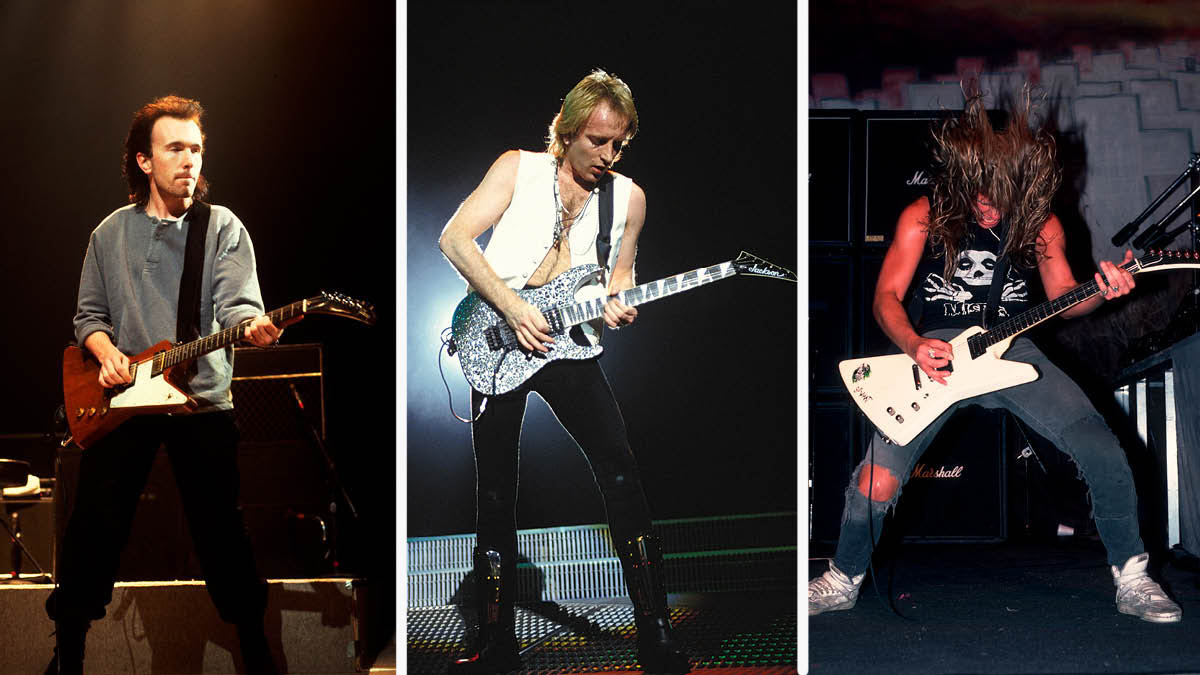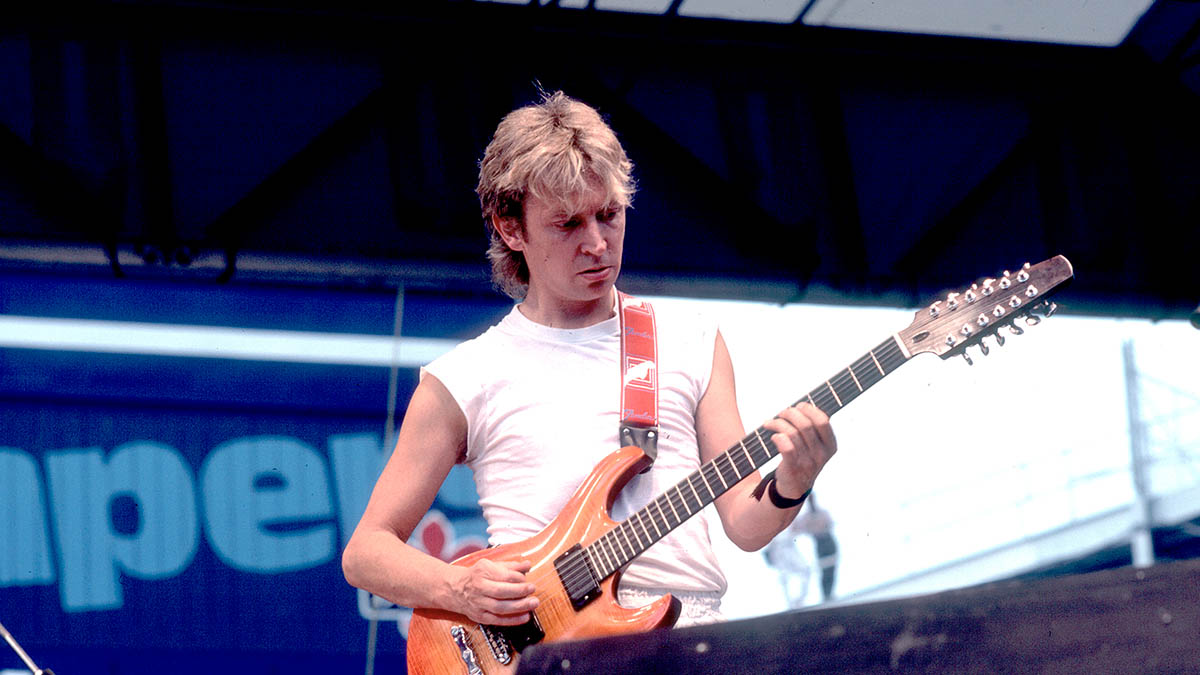Learn the essential techniques of ‘80s guitar
It was the decade of big shoulder pads and formidable guitar playing, and here we have four lessons – all stylistically different – to roll back the clock...

Welcome to our 1980s guitar extravaganza. The aim of this lesson is to take inspiration from the key guitar styles of some of the 1980s’ biggest-selling artists.
Both rhythm and lead guitar ideas are covered, and we’ve notated each of these in the 14 stylistic examples. There are also four mini performance pieces to learn, and by the end of working with these, your ’80s guitar trick bag should be fully topped up.
The 1980s was a decade of excess. Big shoulder pads, power dressing and expensive production values were to the fore. The ’ 80s also ushered in the MTV era and music became even more consumable, with multiple formats available including the introduction of the CD, in addition to vinyl records, cassettes and VHS video.
Various advances in technology led to the advent of more convenient digital effects processors, so the classic ’ 80s production values and guitar sounds are often drenched in chorus, compression and ambience. The decade was also synonymous with other advances in music production technology, such as the introduction of drum machines, and a range of great keyboard synthesisers.
The harmony in ’80s pop music often had a fusion flavour. Sus and slash chords were very much in vogue and it wasn’t uncommon for chart topping hits to feature complex chords and arrangements. Unlike today it was also commonplace for even the most mainstream of songs to feature a guitar, harmonica, synth or sax solo.
The sights and sounds of the ’80s have made a huge comeback in recent years. Styles like ‘Synth Wave’ have copied the production values of the ’80s with titillating precision, adding new compositions for fans of the decade to enjoy.
In fact many modern pop artists have adopted aspects of the ’ 80s sound into their arrangements with great success (Katy Perry, The Weeknd, The Midnight, Taylor Swift etc). Also reboots of classic films (Blade Runner, Ghostbusters, Robocop) and TV series (Cobra Kai, Magnum PI) have become all the rage.
To get our studies going we have recorded seven clean guitar examples in the styles of some of the most popular ’80s genres. Guitar effects such as chorus, compression and ambience are suitably overused. We have also recorded seven overdriven examples using the same over-the-top ‘more is more’ ethos so prevalent at the time.
Our four performance pieces provide an opportunity to put many of the individual examples into musical context. The first is in the style of the classic ’80s rock ballad. This was usually a heartfelt ditty that was often also tied into a major Hollywood movie or two. This type of rock ballad also tended to stay at the top of the singles charts across the the world, for most of the year.
The second is in the style of top 40-synth pop. A huge wave of new romantic bands such as Duran Duran, Spandau Ballet and Ultravox emerged, fusing together drum machines, synthesisers, funky rock guitar – and designer suits – to great effect.
The third is a fist pumping mid-tempo rock track featuring lots of palm muting technique (think big hair, make-up and spandex pants!)
To top off our studies we end with the classic up-tempo boogie. Artists as diverse as ZZ Top and Steely Dan through to Joe Satriani achieved great success with this style of chugging boogie stomper.
As usual you will find the notation and performance notes for all the tracks here. There are also backing tracks provided so you can play along. Hopefully you can find inspiration for your own playing or songs.
’80s Sounds
The use of effects and production techniques can really help to bring a track to life. For this article I used period correct hardware and recorded the parts in a similar way to that of the 1980s.
My 1989 Ibanez RG750 guitar was useful as a main axe of choice. For the clean examples I recorded this electric guitar direct into my Universal Audio preamp. This sounds the same as plugging the instrument straight into a recording console in the studio. Recording direct with no amp creates a super hi-fi tone that is precise and sounds very specific to the era.
This clean tone can then be teamed up with heavy compression and lush chorus. Reverb and ambience effects were also heavily abused in the 1980s so these can be added liberally to drums, guitars and vocals. For the synth parts I used my Roland Juno keyboard and for the drum programming a gated reverb perfectly fitted the bill (think Phil Collins!).
Get the tone
Amp settings: Gain 5, Bass 7, Middle 6, Treble 8, Reverb 4
Although the whole gamut of ‘80s guitar sounds is covered here, from rock to pop to funk and more, it would be impractical to use a bunch of different instruments. So select bridge pickup on one guitar, set the amp quite clean (as above) then add effects as notated at the start of each piece.
Generally more is more if you are looking for that ’80s sound. When playing in any style it is important to have a suitable tone, so study the tab/notation and use your ears.
Clean guitar examples
Example 1. Clean funky chords with chorus
This first example combines snappy 16th-note rhythms with an ’ 80s’style chorus effect. We have notated the strumming pattern for the chords. The chords are answered by bass note popping. You may find it easiest to use the thumb of the fretting hand to hook over the top of the fretboard and play the low C on the 8th fret.
Example 2. Def Leppard-style volume swells
This example adds a volume swell effect (violining). The swell can be achieved with the guitar’s volume control or a volume pedal. The trick here is to strum the chord slightly early and then swell the volume so the chord is heard in time. Volume swells sound most effective with lots of ambience and compression.
Example 3. Andy Summers-style Add9 chords
Our next example highlights the trademark add9 chord fingerings as used by The Police’s Andy Summers (first finger hops over from the sixth to third string). A little bit of slap-back echo is most effective here. This effect is augmented by the addition of a light palm mute, which adds attack to the notes and accentuates the rhythmic quality of the delay.

Example 4. Johnny Marr-style harmonics
In The Smiths, the acknowledged maestro of jangly guitars also used natural harmonics to great effect. Simply place your fingers on the strings lightly over the fret indicated in the tab. As soon as you strike the string lift your finger off to release the harmonic.
Example 5. The Edge S-style Delay
U2 guitarist The Edge made his use of rhythmic delays a trademark sound. Simply set your delay to a dotted eighth-note (many modern delay pedals have this very function, which will be a great boon here).
With this setting engaged and the level turned up, a syncopated delay repeat is added in to fortify the part. The delay also helps with locking into the beat. You can experiment with striking the strings with a dimple grip pick (Herdim Pick) or a coin as this will increase the attack and accentuate the rhythmic effect.
Example 6. Alan Murphy-style sustaining compression
Alan Murphy was a legendary ‘80s session guitarist who played with Kate Bush, Haircut 100, Go West and others. Here we are using compression for a synth pad effect. Strum hard, to provide plenty of level for the compressor to cut or boost.
Example 7. David Williams-style funky popping
David Williams was a master of pop session guitar and his work on hit albums such as Michael Jackson’s Thriller is legendary. To play this popping line keep the fretting hand in contact with the string and only fret the notes when required.
Distorted guitar examples
Example 1. Whitesnake-style palm-muted rock rhythm
This example uses the classic combination of palm muting and the powerchord. Lifting the palm off the strings provides the accents and with a bit of practice these can be included at any point in the bar. Use down picking throughout.
Example 2. Joe Satriani-style divebombs
Whammy bar divebombs provide a dramatic, ear-grabbing sound. Here harmonics on the third and second strings are alternated with the classic sixth-string divebomb. To create the high-pitched Satch-style random squealers, use the fretting hand to lightly touch the strings over the pickups.
Example 3. Steve Stevens-style whammy bar aided melody
Steve Stevens is a master of majestic rock melodies, and uses the whammy bar can to augment them and provide a vocal effect. The end of this phrase may take practice, as all the pitches are created by manipulating the whammy bar.
Example 4. Billy Gibbons-style pinch harmonics
The pinch harmonic is a cool way to add harmonics to a fretted note. Simply use the flesh of the fretting-hand thumb to touch the string at the same moment as you pick. It’s worth using the pickups as a visual marker for where the harmonics are, so you can begin to be less random with the harmonics.
Example 5. Van Halen-style natural harmonics
The way EVH uses natural harmonics to punctuate riffs is another of his trademarks and has become widely imitated. This example uses the same natural harmonics technique as we looked at in the Johnny Marr example.
Example 6. Ty Tabor (Kings X)-style drop D tuning
For this example, simply drop the sixth string a tone (two frets) to D. On a fixed bridge this should be straightforward, but the change in tension on a floating vibrato bridge may require a little more trial and error to get the tuning right.
Example 7. Metallica-style use of the diminished 5 in riffs
For convenience, we continue with drop D tuning (D-A-D-G-B-E). The b5 (here, Ab) works great for heavy riffs and bands like Metalica have cashed in on the dark and menacing sound of the dissonant intervals like the b5 and b2.
Piece 1. Ballad rock
Verse [Bars 1-8] These intro chords are relatively easy to play and sound a whole lot more ’80s with a bit of chorus added. In bar 7 a lead line is introduced and this can be brought to life with a bit of whammy bar wobble.
Chorus [Bars 9-17] The solo starts with a scoop of the whammy bar to create an upward glissando. The ascending Minor Pentatonic (R-b3-4-5-b7)run in bar 13 will benefit from a light palm mute at the start.
Piece 2. Top 40 synth-pop
Chorus 1 [Bars 1-8] Our synth jam provides an opportunity to put some of our clean examples into context. It starts with a slightly changed version of Ex 1.
Verse [Bars 9-16] This section places the David Williams style popping idea we looked at in Example 7 into groovy musical context.
Bridge [Bars 17-24] Here we have added in a new breakdown section, where a palm mute is used to chug on a C note. The picking velocity can be increased and the palm mute removed to create a dynamic shift back into the final chorus.
Chorus 2 [Bars 25-33] The chorus is repeated to end the track.
Piece 3. Mid-tempo rocker
Verse [Bars 1-8] To kick things off we use the palm muting technique we looked at in Example 1 of the distorted examples. The open strings in bars 7-9 can be strummed and allowed to ring alongside the powerchords.
Guitar solo [Bars 9-16] It’s time for a rock guitar wig-out! For the solo the scale of choice is the C# Blues scale (C#-E-F#-G-G#-B); however it sounds good to pick out the B Major arpeggio (B-D#-F#) over the B5 chord in bar 13.
Piece 4. Uptempo swing boogie rocker
To finish, we have a fast-paced boogie rocker. Keep the feel loose and dig in with the pick. To save space we’ve used sectional pointers; Dal Segno Al Coda means go back to the ‘squiggle’ sign, play the music again until the bar marked al Coda, then jump to the coda (circle with a cross in it at bar 17).
Get The Pick Newsletter
All the latest guitar news, interviews, lessons, reviews, deals and more, direct to your inbox!
Jon Bishop is a UK-based guitarist and freelance musician, and a longtime contributor to Guitar Techniques and Total Guitar. He's a graduate of the Academy of Contemporary Music in Guildford and is touring and recording guitarist for British rock 'n' roll royalty Shakin’ Stevens.








![Joe Bonamassa [left] wears a deep blue suit and polka-dotted shirt and plays his green refin Strat; the late Irish blues legend Rory Gallagher [right] screams and inflicts some punishment on his heavily worn number one Stratocaster.](https://cdn.mos.cms.futurecdn.net/cw28h7UBcTVfTLs7p7eiLe.jpg)


